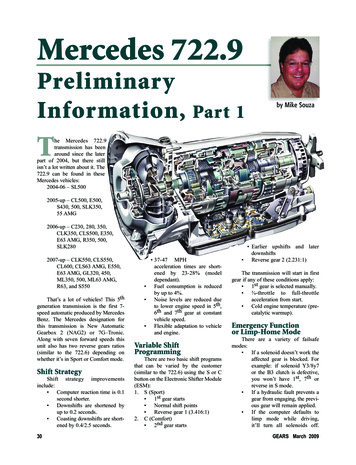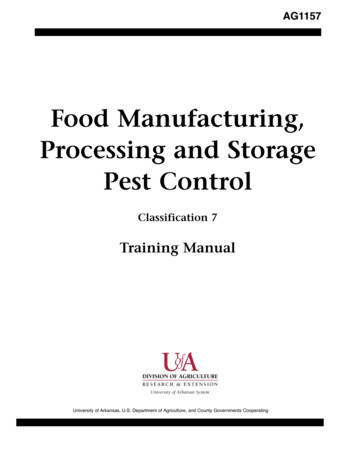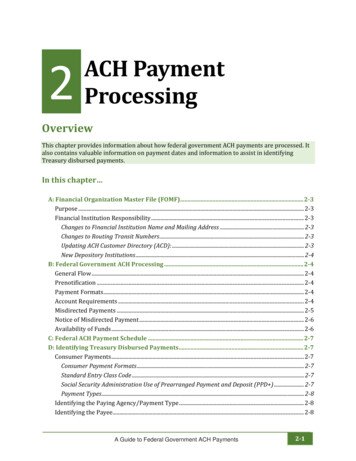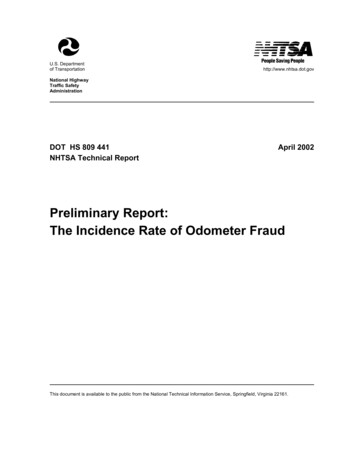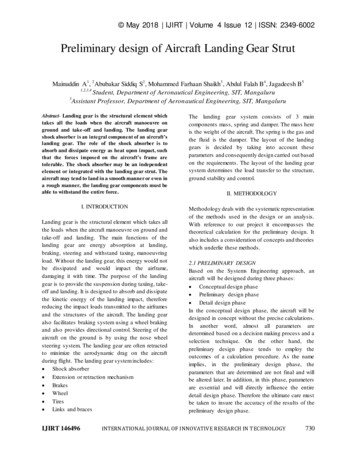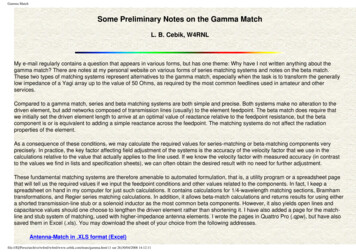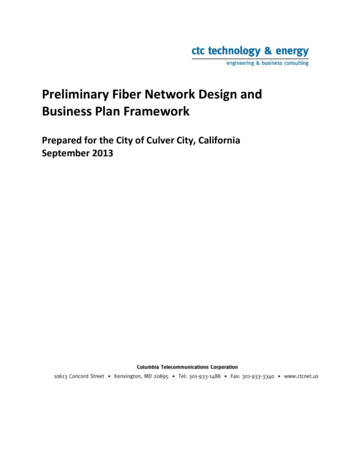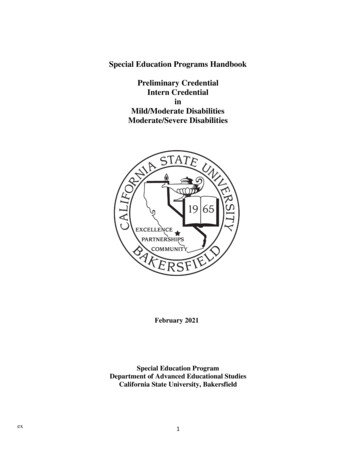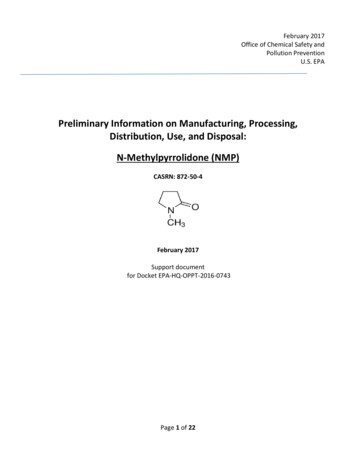
Transcription
February 2017Office of Chemical Safety andPollution PreventionU.S. EPAPreliminary Information on Manufacturing, Processing,Distribution, Use, and Disposal:N-Methylpyrrolidone (NMP)CASRN: 872-50-4February 2017Support documentfor Docket EPA-HQ-OPPT-2016-0743Page 1 of 22
This document provides a preliminary public summary of available information collected by EPA’sOffice of Pollution Prevention and Toxics (OPPT) in the Office of Chemical Safety and PollutionPrevention (OCSPP) on the manufacturing (including importing), processing, distribution in commerce,use, and disposal of this chemical. This is based on existing data available to EPA, including informationcollected under the Chemical Data Reporting rule, Toxic Release Inventory, information from otherAgency databases, other U.S. Government agencies, publicly available information from states, and areview of published literature. In addition, the document includes information reported to EPA byproducers and users of the chemical in the United States and in other countries.This preliminary use information and any additional use information received in the docket by March15, 2017 will inform efforts to develop the scope of the chemical risk evaluation required under section6(b)(4) of the Toxics Substances Control Act, and will inform any risk management efforts following riskevaluation.Mention of trade names in this document does not constitute endorsement by EPA. To verify productsor articles containing this chemical currently in commerce, EPA has identified several examples. Anylists are provided for informational purposes only. EPA and its employees do not endorse any of theproducts or companies.This document does not contain confidential business information (CBI).Page 2 of 22
TABLE OF CONTENTSTABLE OF CONTENTS . 3CONTACT . 3MANUFACTURING, PROCESSING AND USE . 41.2.3.4.5.6.MANUFACTURING (INCLUDING IMPORTING) . 4Manufacturing Process . 4PROCESSING . 5PRODUCTS AND ARTICLES . 7DISTRIBUTION (INCLUDES RETAILERS) . 14USE . 14Use at Industrial Sites . 16Commercial Uses . 16Consumer Uses . 17DISPOSAL OF WASTE AND RECYCLING/RECOVERY . 17Recycling and Recovery . 17Disposal of Waste . 18USEFUL TYPES OF INFORMATION . 18APPENDIX: SOURCES CONSULTED . 19LIST OF TABLESTable 1: Overview of NMP Processing (2012 CDR) . 6Table 2. List of Products . 7Table 3: List of Articles . 12CONTACTAna Corado, Chemical Control Division, Office of Pollution Prevention and Toxics. 202-564-0140,corado.ana@epa.govDocket: EPA-HQ-OPPT-2016-0743Page 3 of 22
MANUFACTURING, PROCESSING AND USE1. Manufacturing (Including Importing)For the 2016 Chemical Data Reporting (CDR) period, data reported indicate that 33 sites in the UnitedStates manufacture (including import) NMP 1. The total volume (in lbs.) of NMP manufactured(including imported) in the United States in 2012 was 164,311,844; in 2013: 168,187,596; in 2014:171,095,221; in 2015: 160,818,058.According to information reported to the 2015 Toxics Release Inventory (TRI), 389 facilities reportedfor NMP 2. Of these, 8 facilities reported domestic manufacture, 7 facilities reported import, 153facilities reported processing, and 289 reported other uses (some sites reported in multiplecategories) 3. According to TRI, in 2015, 3,043,625 lbs. of NMP were transferred offsite to landfillsand/or other treatment/disposal facilities, 5,063,992 lbs. were disposed or released on site for a totalof 8,107,617 lbs. of on an off-site disposal or other releases to air, water, and land.Manufacturing ProcessNMP can be manufactured using different methods. Several references describe two of the methodsfor manufacturing NMP.1) Harreus et al describes the typical method of large-scale manufacture of NMP, by reactingbutyrolactone with an excess of pure or aqueous methylamine in a high pressure tube1Manufacturers (including importers) are required to report under CDR if they meet certain production volume thresholds,generally 25,000 lb or more of a chemical substance at any single site. Reporting is triggered if the annual reportingthreshold is met during any of the calendar years since the last principal reporting year. In general, the reporting thresholdremains 25,000 lb per site. However, a reduced reporting threshold (2,500 lb) now applies to chemical substances subjectto certain TSCA actions. port-under-chemical-data-reporting2A facility must report to the TRI program if it meets all three of the following criteria: 1) is in a specific industry sector, 2)employs 10 or more full-time equivalent employees, and 3) manufactures, processes, or otherwise uses a TRI-listedchemical in quantities above applicable threshold levels for a given chemical in a given year. ogram/basics-tri-reporting3The term "process" in the context of CDR and TRI means the preparation of a chemical substance or mixture, after itsmanufacture, for distribution in commerce—(A) in the same form or physical state as, or in a different form or physical state from, that in which it was received by theperson so preparing such substance or mixture, or(B) as part of an article containing the chemical substance or mixture.http://uscode.house.gov/view.xhtml?path /prelim@title15/chapter53&edition prelimThe term “otherwise use” under TRI means any use of an EPCRA Section 313 chemical, including an EPCRA Section 313chemical contained in a mixture or other trade name product or waste, that is not covered by the terms manufacture orprocess. See the definition of “otherwise use” for additional details on applicability of otherwise use with regard todisposal, stabilization, and treatment for destruction. documents/ry 2015 tri reporting forms and instructions.pdfPage 4 of 22
reaction. Harreus states “the reaction is exothermic and often run under adiabatic conditionswith reactor temperatures in the range of 250-400 degrees Centigrade. The resulting productmixture is decompressed and distilled. The NMP yield is normally more than 14356007.a22 457.pub2/abstract;jsessionid 52B5FB0A52B4A4067F738CFF35BCBAAF.f04t02.2) Johnson-Matthey Process Technologies describes a similar manufacturing process. NMP isproduced by reacting gamma-butyrolactone (GBL) and monomethylamine (MMA), which areproducts of butanediol and methylamines processes respectively. cification/ The process flowsheet is found at the Johnson-Mattheywebsite.3) Mitsubishi produces NMP from maleic Anhydride in an integrated manufacturing process attheir Mizushima siness/chemical/c4/details/1194577 3207.htmlOther methods identified include a non-petroleum-based multi-step process that converts succinic acidinto NMP, identified by researchers at the Pacific Northwest National Laboratory(http://iic.pnnl.gov/abstract/nacs/o 113.pdf), and manufacture of NMP through carbonylation ofallylamine (Ullman’s Encyclopedia of Industrial Chemistry, Harreus Albrecht L et al).Methods of manufacturing may depend on the specifications for the end use. For example, higherpurities of NMP may be required for electronic applications.2. ProcessingThe processing of NMP includes: Petrochemical processing, including acetylene recovery from cracked gas, extraction ofaromatics and butadiene, gas purification (removal of carbon dioxide (CO2) and hydrogensulfide H2S)), and lube oil extraction Reaction medium for the manufacture of high-temperature polymers such aspolyethersulfones, polamideimides and polyaramids Solvent for acrylic and epoxy resins, polyurethane paints, waterborne paints or finishes,printing inks, synthesis/diluent of wire enamels, coalescing agent Solvent and/or co-solvent for liquid formulations of agricultural chemicals Pharmaceutical manufacturing and processing.The table below draws on CDR data to identify the types of processing of the chemical, includingprocessing NMP as a reactant, incorporation into formulation, mixture or reaction products,incorporation into an article, and repacking.Page 5 of 22
Table 1: Overview of NMP Processing (2012 CDR)Industrial Sector (Based onNorth American IndustryClassification System (NAICS))Industrial FunctionType of ProcessingAdhesives and sealantchemicalsProcessing-incorporation intoformulation, mixture orreaction ncorporation intoformulation, mixtures orreactionProcessing-incorporation intoformulation, mixture orreaction productProcessing-incorporation intoformulation, mixture g-incorporation intoarticleSolvent for Adhesives andsealant g-incorporation intoformulation, mixture orreaction productSolvents (which become partof product formulation g as a reactantPaint additives and coatingadditives not described byother categoriesProcessing-incorporation intoarticleProcessing aids, specific to petroleumproductionPaint additives and coating additivesnot described by other categories.Solvents (for cleaning ordegreasing)Solvents (for cleaning ordegreasing)Solvents (which becomepart of product formulationor mixture)Plating agents and surfacetreating agentsProcessing aids, nototherwise listedSolvents (which becomepart of product formulationor mixture)Processing aids, specific topetroleum productionPaint additives and coatingadditives not described byother categoriesPainting and CoatingManufacturingProcessing aids, nototherwise listedIntermediatesPrinting Ink ManufacturingPaint additives and coatingadditives not described byother categoriesPage 6 of 22Solvents (for cleaning or degreasing)Solvents (for cleaning or degreasing)Solvents (which become part ofproduct formulation or mixtures)Plating agents and surface treatingagentsProcessing aids, not otherwise, listed.Solvents (which become part ofproduct formulation or mixture)Processing-incorporation intoformulation, mixture or reactionproductProcessing aids, not otherwise listed.IntermediatesProcessing-incorporation intoformulation, mixture or reactionPaint additives and coating additivesnot described by other categories
3. Products and ArticlesEPA has identified the following examples. This list is provided for informational purposes only. EPAand its employees do not endorse any of the products or companies.Table 2. List of ProductsTrade nameAdhesive/Seam SealerAzek AdhesiveUse of the productAdhesive% by weight ofchemical 85Link to references, SDS or industry informationhttps://azek.com/docs/technical/AZEK adhesive2015 SDS sheet.pdf MSP Seam SealerAutomotive seam 1 lersecretr?mwsId SSSSSuUn zu8l00xl8mxOx2BNv70k17zHvu9lxtD7SSSSSS-- ALBERDINGK U 801Binding /s/us u 801 s.pdfD9100, D9100SW, D9180 Pressure sensitive eimages/410 D9180 11162011.pdfTHERMOSET iles/THERMOSET%2520MA-511 0.pdfDSB 1520Adhesive lubricantNot DelAdhes
Page 1 of 22. February 2017 . Office of Chemical Safety and . Pollution Prevention . U.S. EPA . Preliminary Information on Manufacturing, Processing, Distribution .
